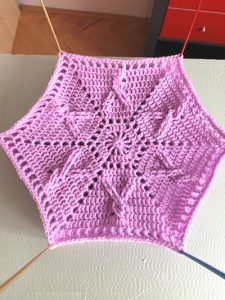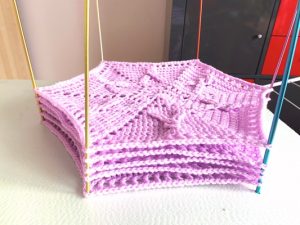After 20 years of experience with knitting and crocheting, I may say .
- Imperfections are human.
- Don’t spoil the joy of work by finding mistakes and wanting to eliminate all imperfections!
- Sometimes you are stricter to yourself than others who do not see imperfection where you see big ones.
But
- A critical approach moves you forward
- You only improve what you consider “not good enough”
- If you present your products and works in public – they should be professionally (i.e., without visible errors and quality imperfections) processed according to general criteria, not yours (do not underestimate or exaggerate)

Blocking is one of the activities to help your knitted or crocheted piece get a professional look.
Please find my experience here:
- I don’t block large units (ready-made blankets, clothes, scarves, shawls, etc.) – I’ll just wash them and spread them to the shape laying on a dryer
- I do not block products or parts of products that hold their shape and do not need to be sized and aligned. I just lay them into shape and store them flatly – e.g., squares for blankets, pillows, etc.
What I’m blocking:
- Squares (and other shapes) for blankets, scarves
Why I’m blocking
- not all squares (and other shapes) are the same,
- the pattern needs to be stretched,
- the edges are not straight (Caution: blocking will not eliminate large differences or errors in pattern, in these cases I would suggest you unwind and correct the pattern, add a row or other corrective activity).
- semi-finished products are better to work with after blocking.
- I have better idea of what the product will look like.
- I’ll find out if there is a need to redo or add an extra line,
- and finally – blocked shapes look much nicer

How do I block
- Material:
- a piece of insulation board as blocking board,
- knitting needles as blocking sticks,
- ruler with line, compass
- Approach:
- I attach a finished square (or hexagon, or other shape). (Note: prior to do that, sew in the protruding threads.)
- I lay the shape on the board and measure it, check the lengths and angles, mark the corners. I remember that the shape must be stretched when blocked.
- I insert needles into the corners, and if necessary, also between (depending on the size of the shape).
- I wash and spin the square or squeeze it into a towel.
- I stretch it on needles (also 3-4 on each other)
- I’ll let it/them dry.
- I put the dried shapes on top of each other and put them in a box, where they are waiting for further processing.
There are also various professional gadgets that you can buy online. This ordinary solution has worked for me at no extra cost. I have a lot of knitting needles and I put the board behind the cabinet, when I do not need it.
Blocking, or how to stretch, adjust and justify the imperfections of crocheted and knitted things
